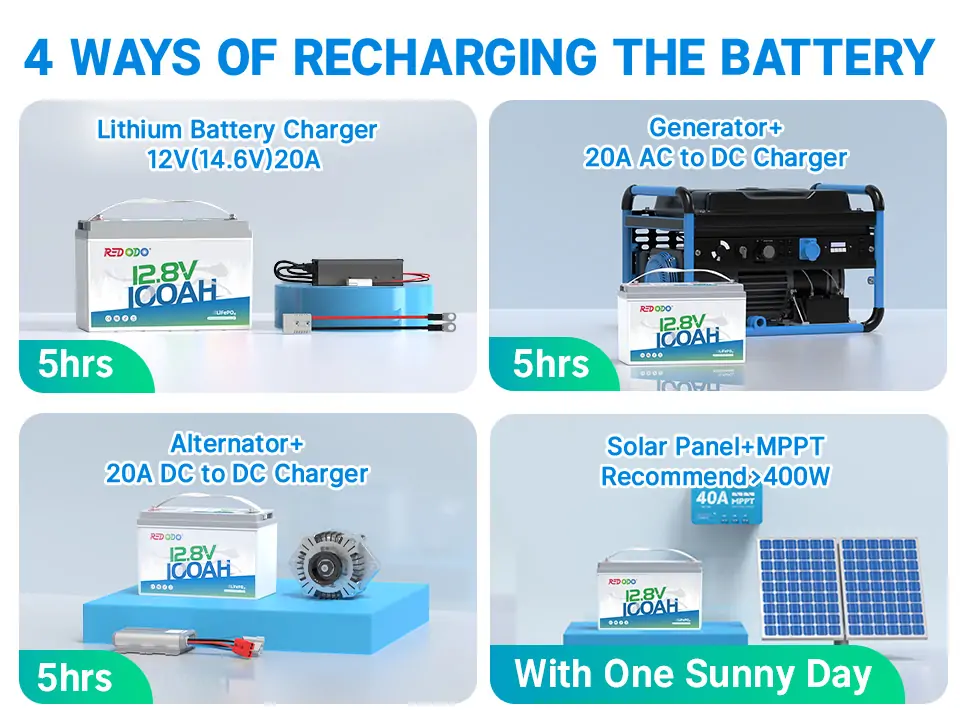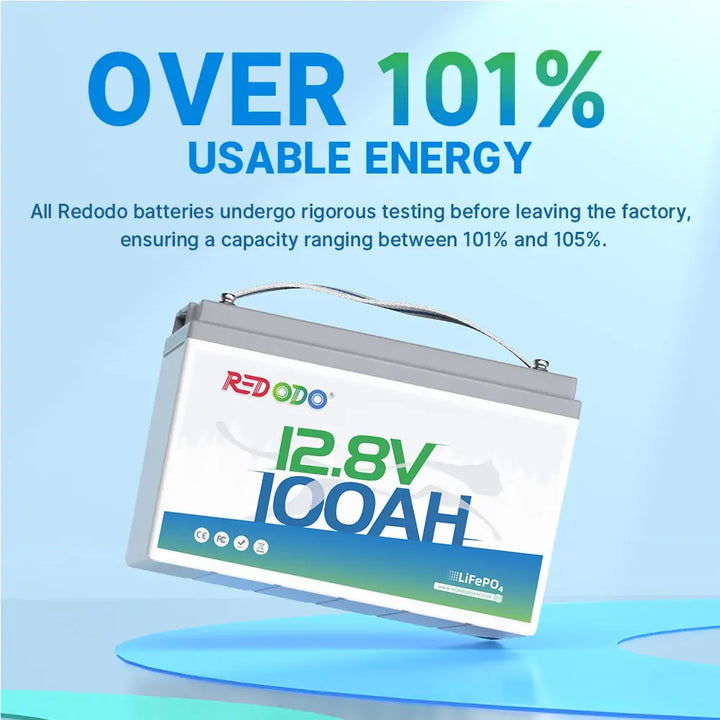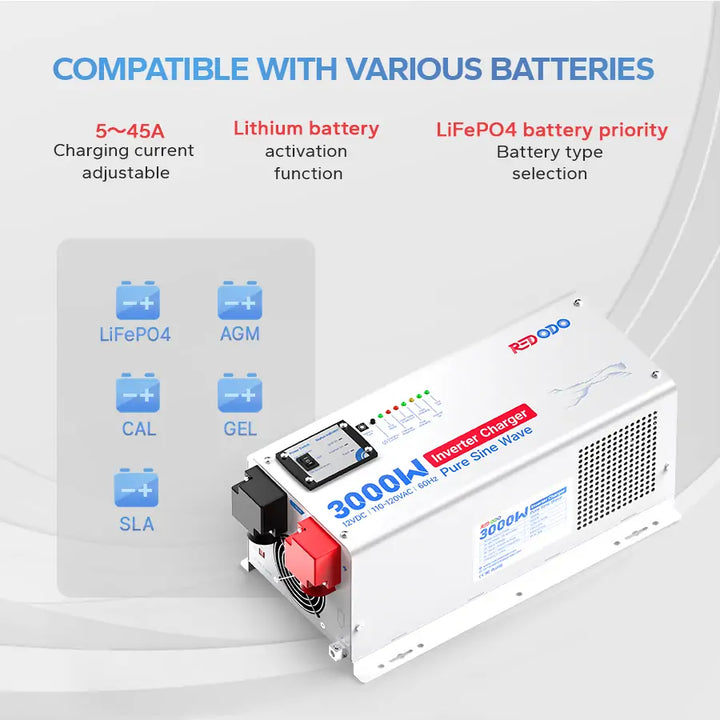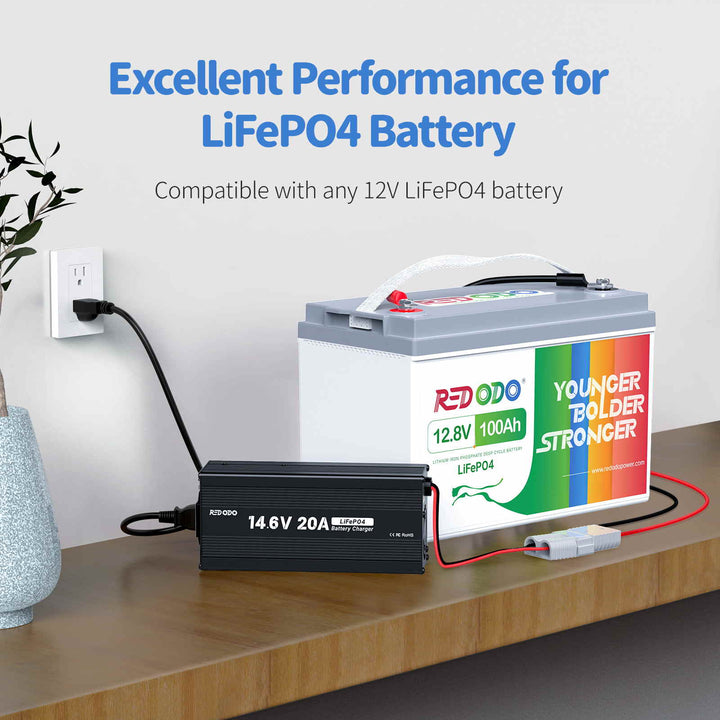A 100Ah lithium battery has become a key player in powering everything from off-grid systems to electric vehicles. Known for its efficiency, longevity, and high energy density, a LiFePO4 lithium battery is a popular choice for both residential and commercial applications. But how long can a 100Ah lithium battery actually last?
This article dives into the essential calculations and considerations for determining the runtime of a 100Ah lithium battery, and helps you understand how to maximize the performance of lithium batteries. Let’s get started!
Table of Content
What Does Ah Mean on a Battery?
The "Ah" (ampere-hour) is a unit used to measure a battery’'s energy capacity. This rating indicates how much current the battery can deliver at a given rate over a set period of time.
For example, a 100Ah lithium battery indicates it can theoretically supply 100 amps of current for 1 hour or 10 amps of current for 10 hours at standard temperature (25°C) in a rated voltage.
How to Calculate 100Ah Lithium Battery Runtime?
Amp-hours are a key measure of how long your battery can consistently power a device before the next charge. Accurately predicting the runtime of a 100Ah lithium battery requires analyzing four interdependent variables through this fundamental formula:
Runtime (hours) = Battery Energy (Wh) ÷ Load Power (Watts)
Battery Energy = Battery Capacity × Voltage × DOD × Inverter Efficiency (option)
For example, the runtime of Redodo 12V 100Ah Group 24 deep cycle battery powering a 60W fridge = 1280Wh ÷ 60W × 90% inverter efficiency = 19.17 hours
Learn More: How Long Will a 100Ah Lithium Battery Run a 12V Fridge?
Now, let’s dissect each component with LiFePO4-specific parameters:
1. Nominal Capacity (Ah)
The nominal capacity rating indicates theoretical charge storage of the cell. In real-world use, factors such as discharge rate, temperature, battery age, and efficiency losses may cause the actual usable capacity to differ slightly from this nominal rating.
2. System Voltage (V)
Standard 12V LiFePO4 batteries exhibit a flat discharge curve:
Effective Voltage Range: 14.6V (fully charged) → 10V (cutoff)
Rated Voltage: 12.8V (industry standard)
3. Depth of Discharge (DOD)
Depth of Discharge (DoD) is a critical factor that determines how much of a battery’s total capacity can be safely utilized without compromising its lifespan.
LiFePO4 batteries can safely discharge up to 100% of their capacity, this means a 100Ah lithium battery can reliably deliver 100Ah of energy before needing to be recharged.
4. Inverter Efficiency (DC to AC)
Inverter efficiency directly affects how much of the battery’s stored energy is successfully converted into usable AC power.
Modern pure sine wave battery inverter, such as those from Redodo, typically achieve 90% efficiency rating, while other modified sine wave inverters usually have efficiency ranging from 85% to 90%.
A 100Ah Lithium Battery Runtime for Common Appliances
Low-Power Devices (20W-200W)
For low-power applications, such as a 40W LED lighting system, a 100Ah lithium battery can provide extended runtime.
With a total usable energy of 1152Wh (calculated from 100Ah × 12.8V × 90% inverter efficiency), a 40W load would yield approximately 28.8 hours of continuous operation.
Medium-Power Devices (300W-800W)
Medium-power appliances, such as a 600W coffee maker, place a higher demand on the battery. Using the same formula, the theoretical runtime is 1.92 hours.
High-Power Devices (1,000W-3,000W)
High-power devices, such as a 1,500W microwave oven, significantly shorten the battery’s runtime.
Theoretically, a 100Ah lithium battery can power a 1,500W load for 0.76 hours (about 45 minutes).
12V 100Ah Lithium Battery Runtime Chart
| Appliance Wattage | Theoretical Runtime | Adjusted Runtime | Discharge Rate |
|---|---|---|---|
| 40W | 28.8h | 27.6h | 0.03C |
| 60W | 19.2h | 18.3h | 0.05C |
| 100W | 11.5h | 10.9h | 0.08C |
| 200W | 5.76h | 5.35h | 0.16C |
| 300W | 3.84h | 3.54h | 0.23C |
| 400W | 2.88h | 2.63h | 0.31C |
| 600W | 1.92h | 1.79h | 0.5C |
| 800W | 1.44h | 1.32h | 0.63C |
| 1,000W | 1.15h | 1.02h | 0.78C |
| 1,500W | 0.76h | 0.62h | 1.17C |
| 2,000W | 0.57h | 0.43h | 1.56C |
| 3,000W | 0.38h | 0.29h | 2.34C |
Here's the 12V 100Ah lithium battery runtime chart for common applications (for reference):
| Application | Theoretical Runtime | Practical Runtime |
|---|---|---|
| 60W LED Television | 19.2h | 15.8h |
| 100W Refrigeration | 1.4 days | 1.88 days |
| 800W Air Conditioner | 1.44h | 1.34h |
| 55 lbs Trolling Motor at 25A (300W) | 3.76h | 2.82h |
| 50W Laptop | 23h | 37.6h |
| 1000W Microwave | 69 minutes | 40 minutes |
Factors Affecting 100Ah Lithium Battery Runtime
While the nominal capacity of a 100Ah lithium battery provides a baseline for runtime calculations, real-world performance is influenced by six key variables:
Discharge Rate (C-rate)
Discharge Rate (C-rate) plays a critical role in determining the effective capacity of a LiFePO4 battery.
A higher discharge rate can slightly reduce the effective capacity of a lithium battery, meaning it might not deliver the full 100Ah if it’s being drained quickly as heat generation increases.
Temperature Conditions
Temperature conditions also significantly impact battery performance.
LiFePO4 batteries operate optimally within a temperature range of 15°C to 35°C. In colder or hotter environments, such as -10°C or above 45°C, the capacity can drop slightly.
Battery Age and Health
An older or heavily cycled battery may not deliver the full 100Ah it did when it was new, shortening runtime.
If your battery has been in use for several years and exhibits reduced discharge times along with an increased need for recharging, it may be a sign that your battery is failing and needs to be replaced.
Related Reading: How to Test a Deep Cycle Battery and Tell If It Bad
Inverter Efficiency (for AC-powered Devices)
If you’re using an inverter to power AC appliances, the inverter itself consumes energy during operation. Lower-efficiency inverters waste more power, meaning less energy from the battery actually reaches your devices.
Charging Ways of 100Ah Lithium Battery
A 100Ah lithium battery can be conveniently charged through several methods, giving you flexibility whether you're at home, outdoors, or on the move. Here are four recommended charging options:
1. AC LiFePO4 Charger
Using a dedicated 20A LiFePO4 battery charger is a reliable and safe method. It typically takes about 5 hours to fully charge the battery. It is recommended that using 0.2C charging rate for charging a 100Ah battery.
2. Solar Panel with MPPT Charge Controller
If you have access to solar panels and favorable weather, you can recharge your RV solar battery over the course of one sunny day. This eco-friendly method is perfect for off-grid adventures and sustainable energy use.
Note: The MPPT solar charge controller should meet the voltage and power requirements of your lithium battery.
3. Generator
When off-grid or during emergencies, a generator paired with an AC-DC charger can efficiently charge your lithium battery. This method ensures you stay powered even without access to the electrical grid.
4. Alternator
For RVs, boats, and vehicles, you can use a vehicle alternator combined with a DC-DC charger. This setup is a practical choice during travel, saving your charging time.
Read More: How To Charge LiFePO4 Battery

FAQs about 12V 100Ah Lithium Battery
1. What Size Solar Panel is Needed for a 100Ah Lithium Battery?
A 150 to 200W solar panel is typically required to recharge a 12V 100Ah lithium ion solar battery within 6-8 hours under optimal conditions. This calculation accounts for:
Daily Recharge Needs: 100Ah × 12.8V × 90% DOD = 1,152Wh
Solar Efficiency: 75% derating for real-world losses (clouds, angle, wiring)
Panel Wattage = (Daily Wh ÷ Sun Hours) ÷ Efficiency
Your required solar panel wattage would be 1,152Wh ÷ 6h ÷ 0.75 = 144W.
2. What Size Inverter Fits a 12V 100Ah Lithium Battery?
Select an inverter rated for 1.5x your maximum continuous load:
Continuous Power: Match to 0.8C battery discharge (12V × 100Ah × 0.8 = 960W)
Peak Handling: Choose inverters with 200% surge capacity (e.g., 2,000W surge for 1,000W loads)
Recommended configurations for examples:
| Load Type | Inverter Size | Runtime @100Ah |
|---|---|---|
| Lights + Phone | 300W | 18h (50W load) |
| Microwave + TV | 1,000W | 1.1h (800W) |
| Power Tools | 2,000W | 0.6h (1,500W) |
3. Is a 100Ah Lithium Battery Sufficient for Camping?
A 100Ah lithium battery can easily last 2-3 days or more, making it a reliable choice for most camping trips.
For example, a typical camping setup might include LED lights, a portable fridge, and device charging.
LED lights running for 5 hours a day consume about 50Wh, while a 12V portable fridge running continuously uses around 1,440Wh. Charging phones or other small devices adds another 15Wh. This totals 1,505Wh, which slightly exceeds the 1,280Wh usable capacity of a 100Ah lithium battery.
4. How Long to Charge a 100Ah Battery with 150W Solar?
Charging a 100Ah lithium battery with a 150W solar panel depends on sunlight conditions and system efficiency. Under ideal conditions, it takes approximately 10 hours to fully charge the battery from empty.
However, real-world factors like cloudy weather, panel angle, and system losses can reduce efficiency.
Conclusion
A 12V 100Ah lithium battery is a common power source for energy storage, offering unparalleled efficiency, durability, and versatility. Whether you’re powering a home, RV, or marine application, its high energy density, long cycle life, and fast charging capabilities make it a reliable choice.
For a trusted solution, consider Redodo’s 12V 100Ah lithium battery series. The wide options feature smart Bluetooth monitoring, advanced BMS protection, and EV-grade LiFePO4 cells for 4,000+ cycles. With 1280Wh capacity and lightweight design, it’s perfect for any energy need.
Upgrade to Redodo today and experience reliable, high-performance power for all your adventures!
Read More:
How Many Solar Batteries Do I Need to Power a House?
How Long Will a 100Ah Battery Run a 55lb Trolling Motor?
How Long will A 200Ah Battery Run An Air Conditioner?

Redodo

Redodo
Recent Post

How Long Will a 12V 100Ah Lithium Battery Last?

6 Best Lightweight Trolling Motor Batteries in 2025

How Long Does a Trolling Motor Battery Last?

Convert RV from Lead-Acid to Lithium Battery: A Complete Guide




![⚡[$220 after Sign-Up] Redodo 12V 100Ah Group 24 Deep Cycle LiFePO4 Lithium Battery | For Home, RV, Marine](http://www.redodopower.com/cdn/shop/files/Redodo_12V_100Ah_group_24_lithium_battery_6301965d-f6e8-467f-825f-3eec839b3e1f.jpg?v=1744105344)
![⚡[$220 after Sign-Up] Redodo 12V 100Ah Group 31 Bluetooth Lithium Battery | Real-Time Battery Monitoring | For RV, Marine, Solar](http://www.redodopower.com/cdn/shop/files/Redodo_12V_100ah_group31_bluetooth_lithium_battery.jpg?v=1745565708)
![⚡[$220 after Sign-Up] Redodo 12V 100Ah LiFePO4 Lithium Battery | Best Budget | For RV, Solar, Trolling Motor](http://www.redodopower.com/cdn/shop/files/Redodo_12v_100ah_lithium_battery_b9015ddd-64b5-4be2-8c88-392f0bb4ab30.jpg?v=1742973160)
![⚡[$220 after Sign-Up] Redodo 12V 100Ah Lithium Trolling Motor Battery With Low Temp Protection](http://www.redodopower.com/cdn/shop/files/Redodo12V100Ahlow-tempbattery.webp?v=1738462317)
![⚡[$220 after Sign-Up] Redodo 12V 100Ah Mini Lithium LiFePO4 Battery | Smallest Battery | For RV, Trolling Motor, Solar](http://www.redodopower.com/cdn/shop/files/Redodo12V100AhMiniLiFePO4LithiumBattery.jpg?v=1739959054)
![⚡[$239 after Sign-Up] Redodo 12V 100Ah Group 24 Bluetooth LiFePO4 Battery | Real-Time Battery Monitoring | For RV, Marine, Solar](http://www.redodopower.com/cdn/shop/files/Redodo_12V_100Ah_group_24_bluetooth_lithium_battery.jpg?v=1744253032)
![⚡[$239 after Sign-Up] Redodo 12V 100Ah Mini Bluetooth LiFePO4 Battery | For RV, Marine, Solar](http://www.redodopower.com/cdn/shop/files/12V100AhMiniSmartLiFePO4LithiumBatterywithBluetooth1.webp?v=1741251007)
![⚡[$248 after Sign-Up] Redodo 12V 100Ah Plus Bluetooth Marine Battery | For Marine, Trolling Motors, RV](http://www.redodopower.com/cdn/shop/files/Redodo12V100AhOBMOutboardMotorLithiumMarineBattery.webp?v=1743584091)


![⚡[$377 after Sign-Up] Redodo 12V 200Ah Lithium LiFePO4 Battery | 1280W Load Power | For RV, Solar, Off-Grid](http://www.redodopower.com/cdn/shop/files/Redodo12V200ahlithiumbattery.jpg?v=1735892910)
![⚡[$524 after Sign-Up] Redodo 12V 300Ah Lithium LiFePO4 Battery | Replaces 6*12V 100Ah AGM Batteries | RV, Marine, Solar](http://www.redodopower.com/cdn/shop/files/Redodo_12V_300ah_lithium_deep_cycle_battery.png?v=1744797523)